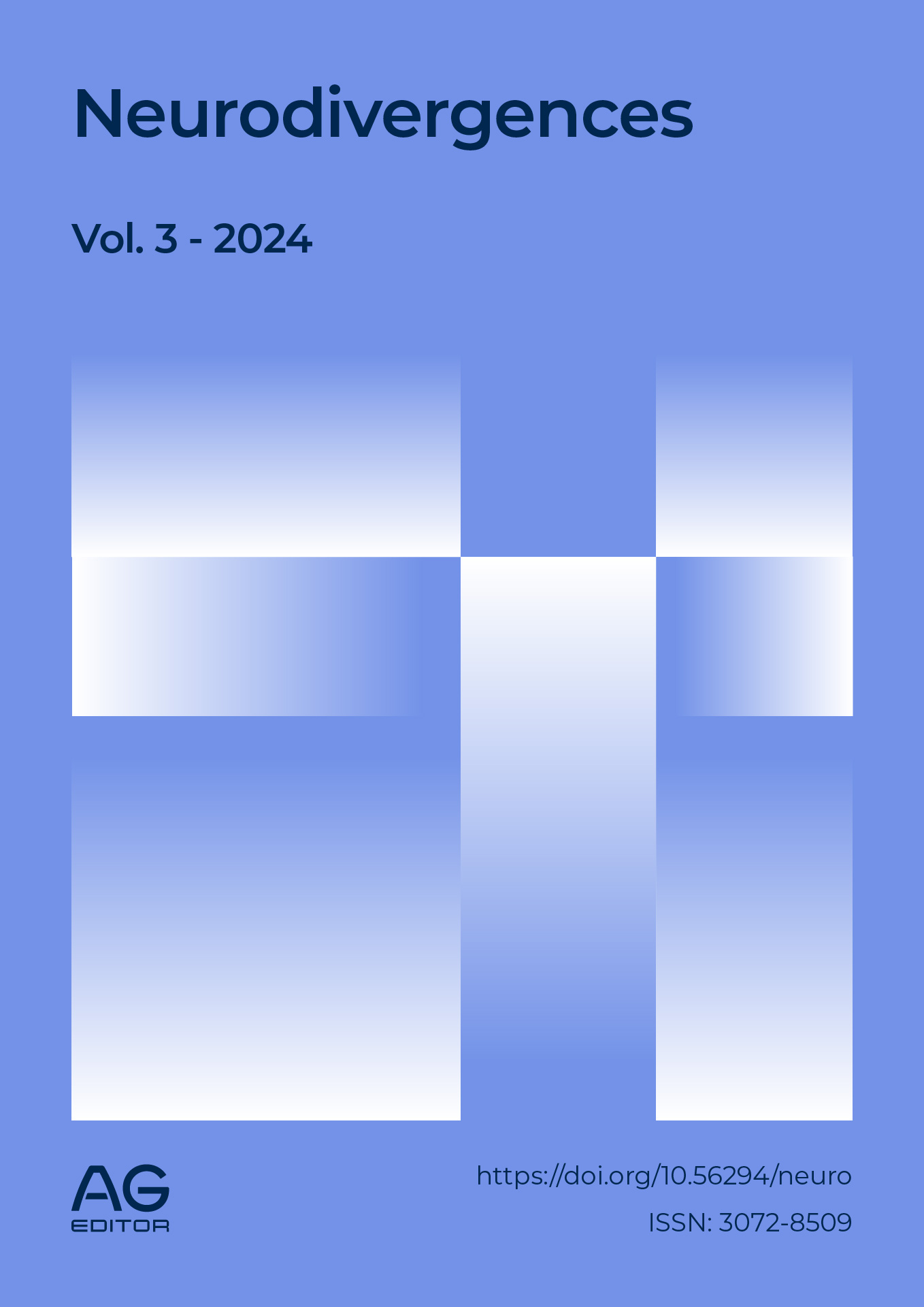Current developments in autism and neurodevelopmental disorders: research and practice
DOI:
https://doi.org/10.56294/neuro2024127Keywords:
Autism, Neurodevelopmental Disorders, Sensory Processing, Communication, Masking, ComorbiditiesAbstract
Introduction: neurodevelopmental disorders (NDDs), such as Autism Spectrum Disorder (ASD), ADHD, and others, affect the development of the central nervous system, manifesting in cognitive, social, and emotional challenges. The prevalence of autism has increased significantly, from 1 in 50 children in 2000 to 1 in 44 today. Genetic, prenatal, and environmental factors influence its development, and current research focuses on neurobiological, diagnostic, and therapeutic advances.
Development: the review highlights advances in the early identification of ASD, such as tablet-based tools and visual biomarkers, which allow for more accessible diagnoses. It also explores differences in sensory processing, with hypersensitivity and hyposensitivity, and their impact on daily life, proposing practical strategies such as environmental adaptations and occupational therapies. Common comorbidities, such as epilepsy and gastrointestinal disorders, are addressed, emphasizing the need for integrated approaches to diagnosis and treatment. and explores a strengths-based model that encourages self-acceptance and the use of unique abilities to improve well-being and educational and employment outcomes.
Conclusions: current research converges toward an approach that values neurodiversity, prioritizes early identification, and promotes personalized interventions. The importance of addressing sensory, communicative, and emotional needs from a holistic perspective is highlighted. Future research should delve deeper into the implementation of strengths-based strategies and the reduction of masking, with the goal of improving the quality of life and inclusion of autistic individuals.
References
1. Thapar, A, Miriam C, and Michael R. "Neurodevelopmental disorders." The Lancet Psychiatry 4.4 (2017): 339-346. https://kclpure.kcl.ac.uk/portal/files/62871875/Neurodevelopmental_disorders_THAPAR_Accepted2016_GREEN_AAM.pdf
2. Lord, Catherine, et al. "Autism spectrum disorders." Neuron 28.2 (2000): 355-363. https://www.cell.com/neuron/pdf/S0896-6273(00)00115-X.pdf
3. Lord, C., Brugha, T.S., Charman, T. et al. Autism spectrum disorder. Nat Rev Dis Primers 6, 5 (2020). https://doi.org/10.1038/s41572-019-0138-4
4. The Connection Between Autism and Sensory Processing Disorder, https://www.mastermindbehavior.com/post/the-connection-between-autism-and-sensory-processing-disorder
5. He, Jason L., et al. "A working taxonomy for describing the sensory differences of autism." Molecular Autism 14.1 (2023): 15. https://link.springer.com/content/pdf/10.1186/s13229-022-00534-1.pdf
6. Brentani, Helena, et al. "Autism spectrum disorders: an overview on diagnosis and treatment." Brazilian Journal of Psychiatry 35 (2013): S62-S72. https://www.scielo.br/j/rbp/a/GXxmGC7gqrG8FMhzLB5RcLw/
7. Bishop, D, Michael R. "Neurodevelopmental disorders: conceptual issues." Rutter's child and adolescent psychiatry (2008): 32-41. https://onlinelibrary.wiley.com/doi/pdf/10.1002/9781444300895#page=53
8. Autism Society. Intervention and Therapies. https://autismsociety.org/resources/intervention-and-therapies/
9. Papadopoulos, Dimitrios. "A general overview of the pragmatic language-social skills and interventions for children with autism spectrum disorders." Autism Open Access 8.225 (2018): 2. https://www.researchgate.net/profile/Dimitrios-Papadopoulos-3/publication/324106466_A_General_Overview_of_the_Pragmatic_Language-Social_Skills_and_Interventions_for_Children_with_Autism_Spectrum_Disorders/links/5abe555345851584fa719ec1/A-General-Overview-of-the-Pragmatic-Language-Social-Skills-and-Interventions-for-Children-with-Autism-Spectrum-Disorders.pdf?_sg%5B0%5D=started_experiment_milestone&origin=journalDetail
10. Davis III, Thompson E., et al. "The relationship between autism spectrum disorders and anxiety: The moderating effect of communication." Research in Autism Spectrum Disorders 5.1 (2011): 324-329. https://www.sciencedirect.com/science/article/pii/S175094671000067X
11. Casanova, Manuel F., et al. "Comorbidity and autism spectrum disorder." Frontiers in psychiatry 11 (2020): 617395. https://www.frontiersin.org/journals/psychiatry/articles/10.3389/fpsyt.2020.617395/pdf
12. Alaghband-Rad, Javad, Arman Hajikarim-Hamedani, and Mahtab Motamed. "Camouflage and masking behavior in adult autism." Frontiers in psychiatry 14 (2023): 1108110. https://www.frontiersin.org/journals/psychiatry/articles/10.3389/fpsyt.2023.1108110/pdf
13. Pearson, Amy, and Kieran Rose. "A conceptual analysis of autistic masking: Understanding the narrative of stigma and the illusion of choice." Autism in Adulthood 3.1 (2021): 52-60. https://www.liebertpub.com/doi/pdf/10.1089/aut.2020.0043
14. Gargaro, Belinda A., et al. "Autism and ADHD: how far have we come in the comorbidity debate?." Neuroscience & Biobehavioral Reviews 35.5 (2011): 1081-1088. https://www.sciencedirect.com/science/article/pii/S0149763410001831
15. Middletown Centre for Autism. Strength-based Approaches. https://www.middletownautism.com/files/uploads/5624747fe9fc19de207892e4d0487bd0.pdf
16. Murthi, Kavitha, et al. "Strengths-based practice to enhance mental health for autistic people: A scoping review." The American Journal of Occupational Therapy 77.2 2023: 7702185060. https://research.aota.org/ajot/article-abstract/77/2/7702185060/24094
17. Taylor EC, Livingston LA, Clutterbuck RA, Callan MJ, Shah P. Psychological strengths and well-being: Strengths use predicts quality of life, well-being and mental health in autism. Autism. 2023 Aug;27(6):1826-1839. https://pmc.ncbi.nlm.nih.gov/articles/PMC10375006/
18. Hastings M. Positive Psychology, Neurodiversity and Reframing Autism Research, https://news.cuanschutz.edu/news-stories/positive-psychology-neurodiversity-and-reframing-autism-research
19. Lanou, A., Hough, L., & Powell, E. Case Studies on Using Strengths and Interests to Address the Needs of Students With Autism Spectrum Disorders. Intervention in School and Clinic, 2011, 47(3), 175-182. https://doi.org/10.1177/1053451211423819.
Published
Issue
Section
License
Copyright (c) 2024 Erika Silvia Stolino , Carlos Jesús Canova-Barrios (Author)

This work is licensed under a Creative Commons Attribution 4.0 International License.
The article is distributed under the Creative Commons Attribution 4.0 License. Unless otherwise stated, associated published material is distributed under the same licence.






